Scratch Weaned Speed Original Design / Scratch Built
Scratch - Weaned Speed {Scratch}
Contributed by Scott Turnbull
| Manufacturer: | Scratch |
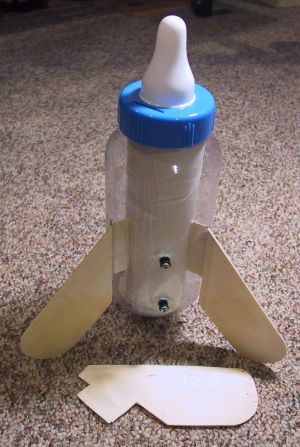
Brief:
This odd rocket is a baby bottle bank converted to a 29mm powered rocket with three back swept fins.
Construction:
Bill of materials:
- 1 Baby Bottle Bank (from the baby shower section of a party store)
- 1 Mailing Tube for the interior stuffer
- 1 29mm Motor Mount Tube
- 2 Two Centering Rings cut from Clementine crate plywood
- 3 Swept Back Fins cut from Clementine crate plywood
- 1 reinforcing bulkhead for the bottle top
- 1 sewing elastic harness
- 2 T-nuts, bolts, and screen clips for motor retention
This rocket came about from a desire to test some construction techniques planned for use on the much larger Coors Flight flying bank, which is also described on this site.
I purchased the Baby Bottle Bank at a local party store. It was in the Baby Shower supplies section.
A mailing tube that is a press fit into the mouth of the bottle was used to size a hole cut in the base of the bottle using a drill mounted hole saw.
Clementine fruit crate wood was used to cut out the three back swept fins and two centering rings. T-nuts were inserted into the aft centering ring for motor retention.
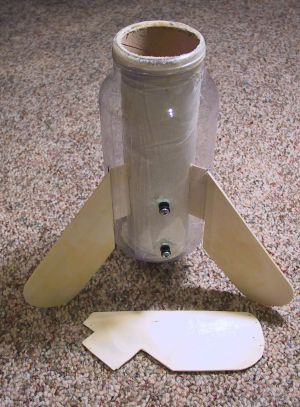
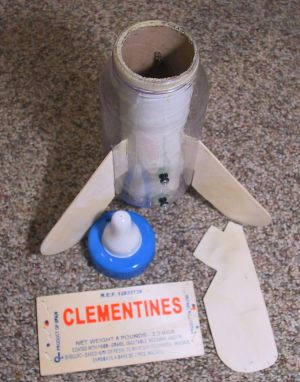
Fin tabs were fashioned to go straight through from the outer bank wall, through the mailing tube wall, and up against the motor mount tube. The slots were cut with a Dremel tool using ganged cutting disks. This thick cutting disk cut each slot in a single pass.
A steel fishing leader is attached to the motor mount and ends just below the mouth of the bottle. To this is attached the elastic shock cord.
A wood disk is bolted inside the bottle cap for additional strength and weight. A screw eye provides the mounting point for the recovery elastic. The threading on the inside of the cap was ground off to provide the slip fit needed to eject the cap.
Finishing:
Finishing consisted of painting the wooden fins.
Flight and Recovery:
This has flown several times over the past year. The initial flight was on an E16-5 reload for an AeroTech 29/40-120
case. It was an arrow straight boost and a soft recovery.
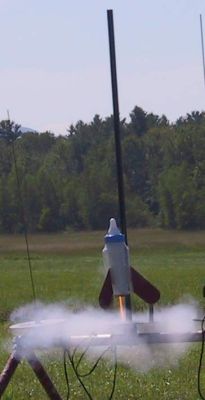
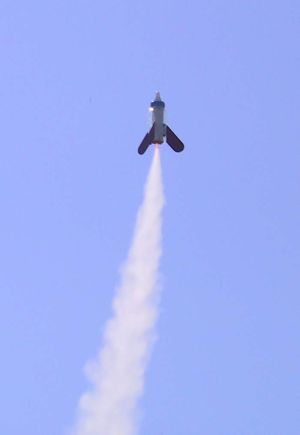
I tried it once on a D12-3 using a 29-24 adapter but that flight was barely a hand toss high. It was safe but uninspiring.
A flight on an E23 with a drilled delay of approximately 4 seconds had an excellent boost and a seemingly gentle recovery, but two fins were snapped off across the narrow dimension from a fin slot to the leading edge. It was re-glued and will fly again.
Summary:
This was a good learning vehicle for the double through the wall fin construction needed for "facade"
rockets. If I were to build it again, I would make the fin tabs so that there is not such a weakness at the narrow
dimension between the fin slot and leading edge. Large angled tabs, rather than small perpendicular ones, would make it
stronger. I would also use Lexan for the fins so that the fins were effectively invisible.
Sponsored Ads
 |
 |











